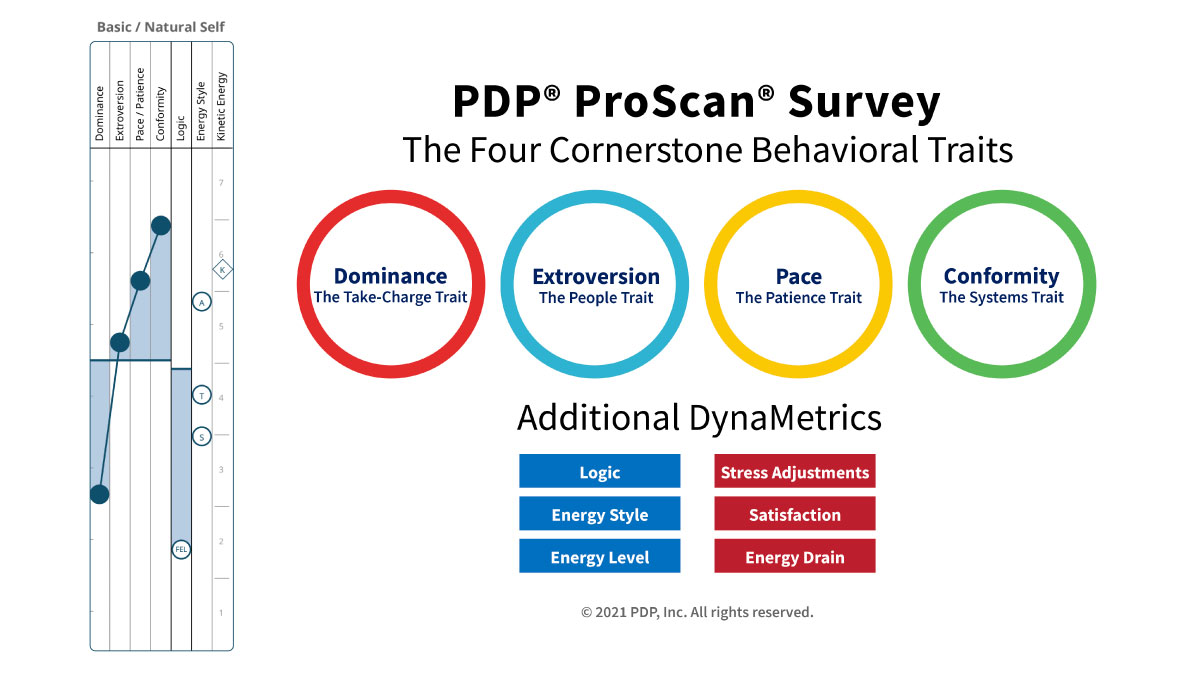PDP ProScan vs Predictive Index Behavioral Assessments
by Brent W. Hubby, on Dec 14, 2022 9:41:00 AM

The Predictive Index (PI) behavioral assessment is one behavior assessment commonly used in businesses. Developed in the 1950s, the PI behavioral assessment attempts to measure work-related personality traits to find behavioral drives that predict job performance.
So how does the Predictive Index Behavioral Assessment compare with the PDP Management System?
We cover the similarities and differences between the two assessments and explain why PDP is your proven people management system for selection, motivation, and retention.
Origins
Predictive Index Behavioral Assessment
The Predictive Index Behavioral Assessments originated in the work of Arnold Daniels, a volunteer in the U.S. Army Air Corps. He earned a reputation for logging more than 30 missions as a flight navigator in England in 1942, without a single combat casualty. Seeing his team’s records, commanders sent a psychologist to study the team.
This was Daniels’ first introduction to psychometric testing, and he saw that it could be useful in the context of business. He developed the first Predictive Index Assessment in 1955.
PDP ProScan Behavioral Assessment
PDP Global was founded by Bruce M. Hubby, who was a Predictive Index analyst beforehand. He advocated for more research to validate the PI assessment and, at the urging of colleagues and statisticians, eventually started from scratch to develop the most accurate and objective survey instrument. His first survey, ProScan, was a statistically-validated instrument to help businesses select the right candidates for a job. Eventually, that assessment expanded into the proven people management system that it is today.
Unlike most other personality profiling systems, Hubby constructed PDP’s assessments using a rigorous testing methodology and a focus on statistical integrity. 185 adjectives for personality were identified to build ProScan based on the work of eminent psychologists like Thurstone, Cattell, Guilford, and Fiske. Since the 1970s, we’ve regularly conducted research to confirm and improve the reliability and validity of our assessments. The result is very accurate assessments, with 98% of individuals surveyed since 1977 agreeing in field testing that their ProScan results are accurate.
Output
Predictive Index Behavioral Assessment
The Predictive Index Behavioral Assessments provide two main outputs. The job assessment produces a model of desired behavioral traits for a particular position. The behavior assessment uses self-reported descriptions of adjectives to produce ratings on each of the four personality traits—A, B, C, and D (e.g., dominance, extroversion, patience, and formality).
The assessment uses the same set of adjectives for two perspectives: how they are and how they think others expect them to be. Such a structure is easier to cheat or skew and manipulate results since respondents can make one-to-one comparisons. Also, respondents can choose to skip questions, which distorts findings since adjectives are interwoven with each other.
Individuals are then assigned one of 17 reference profiles and a description of strengths, blindspots, and management tips. These reference profiles are useful because people can identify themselves in a particular role, but the tradeoff is that it forces everyone into a limited set of profiles. It doesn’t make space for the full spectrum of various personality traits that one might see in potential job candidates.
PDP ProScan Behavioral Assessment
PDP JobScan is similar to the PI job assessment in that it measures the key traits that are desirable for a particular position. The PDP ProScan Survey can then assess individuals for their behavioral traits and match them against the profile desired for a particular job.
However, there are some important differences between PDP and PI behavioral assessments. PDP’s ProScan uses a five-point Likert scale to measure how strongly someone agrees or disagrees, which provides better granularity than the PI assessment method of simply checking black-or-white word descriptor boxes. ProScan then provides summary paragraphs that describe each individual’s traits, rather than assign them a personality type. Summary paragraphs allow for much more diversity and flexibility and don’t confine candidates to pre-defined personality types.
ProScan also measures employee satisfaction and energy drain while PI does not. ProScan reports take the two sets of behavioral data (from an individual's natural state and also how they feel they should be) and determine the stress an employee feels as they try to adjust between the two. For example, if someone is more introverted but must talk to many others all day for their role, they could be over-extending their natural trait. ProScan predicts whether the adaption of someone's natural trait tendencies compared to how they feel they need to be will result in positive or negative job satisfaction overall. Moreover, ProScan considers energy drain to reveal whether an employee is on the verge of burnout. The amount of energy an employee starts with at the beginning of the day versus the energy that's left after the day's demands is the energy drain metric. Someone may feel continually exhausted if the energy drain is too great since employee well-being, productivity, and performance stem from energy.
PDP also offers TeamScan that helps business leaders understand the success drivers of their core teams and the entire organization. This unique instrument helps increase team harmony and build a productive organizational culture.
Research Validation
Predictive Index Behavioral Assessment
PI behavioral assessments appear to be validated, especially compared to some of the other brands used in the field. Although studies aren’t available for public viewing, they suggest to have conducted over 400 job performance studies on over 25,000 participants.
It’s not clear whether PI used confirmatory factor analysis—the gold standard for psychometric test construction—to produce their tests. But despite that potential weakness, there does appear to be good evidence for the reliability and validity of the PI tests.
PDP ProScan Behavioral Assessment
We developed ProScan with a specific focus on creating a reliable, valid, and useful instrument for talent management. The Chronbach alpha coefficient was 0.94 for the first version of the ProScan Survey, indicating excellent reliability and vastly outperforming the benchmark score of 0.70 considered acceptably reliable.
We’ve continued to ensure that ProScan is reliable and valid since its initial development. Most recently, we conducted a multi-year series of studies that ended in 2021 that resulted in 11 Exploratory Factor Analyses (EFA) and three Confirmatory Factor Analyses (CFA). Over 39,000 working adults participated in our research to optimize the ProScan structure and verbiage. Language evolves over time and utilizing the best set of survey adjectives was imperative to ProScan’s continued impact for businesses. Few personality profiling companies go beyond EFAs to complete CFAs since the process and research is highly rigorous, which is why our tests are some of the most accurate in the industry.
Use Cases
Predictive Index Behavioral Assessment
PI behavioral assessments match a candidate’s personality profile to a position profile. Managers use PI results almost exclusively for managing people, and typically don’t share the results with employees. This top-down approach limits the extent to which employees can use the results for their own self-awareness or to guide professional development. The profile descriptions are also quite short, which also contributes to their limited utility for helping employees use the reports to improve their performance.
PDP ProScan Behavioral Assessment
PDP Global’s suite of behavioral assessments is much more comprehensive. Like the PI instruments, PDP’s management system aids hiring decisions—it’s been shown to predict job performance as well as be free of bias, meaning it doesn’t guide managers to make disparate hiring decisions based on demographic group membership. PDP assessments conform to American Psychological Association testing standards, have been successfully evaluated by the Center for Applied Psychology at the University of Colorado at Denver, and adhere to the Society for Industrial Organizational Psychology’s principles for personnel testing and selection. We also offer Equal Employment Opportunity Commission (EEOC) and Americans with Disabilities Act (ADA) compliant certification courses for users who will administer PDP assessments in their organization.

PDP’s assessments are much more than just hiring and selection instruments. ProScan offers a comprehensive set of reports for individuals that are valuable as guides for self-development and for managers to understand how to best support individual members of their team. TeamScan takes this one step further, delivering insights that organizations can use to build high-performing teams.
Employers use PDP assessments to:
- Increase morale, job satisfaction, and team harmony
- Decrease employee turnover
- Standardize hiring procedures and make them more efficient
- Match people to the tasks they’re best suited to
- Improve interviews with job applicants and the selection of new employees
- Reduce employee interpersonal conflicts
- Increase productivity and profits
- Measure and reduce employee stress
- Identify employees who are near burnout
- Uncover employees operating in “quiet quitting” mode
Hire, Motivate, and Retain with PDP Behavioral Assessments
PDP assessments help you build effective team cultures. They give you the power to select the people who are the best fit for a job, build team morale, and become more productive.
Curious how PDP can help take your team to the next level? Try a complimentary PDP assessment.













